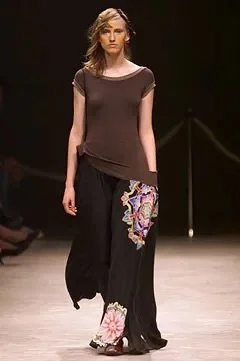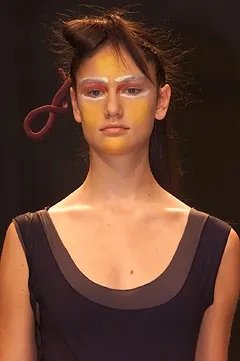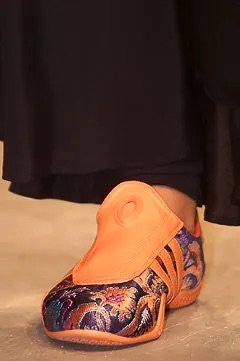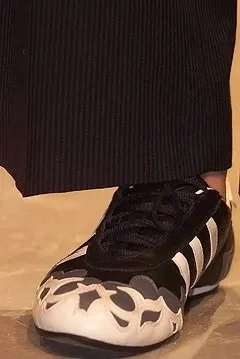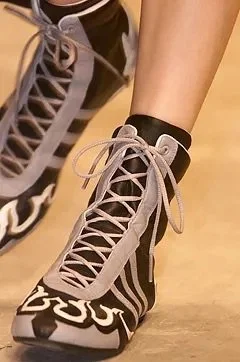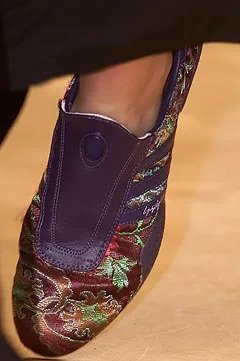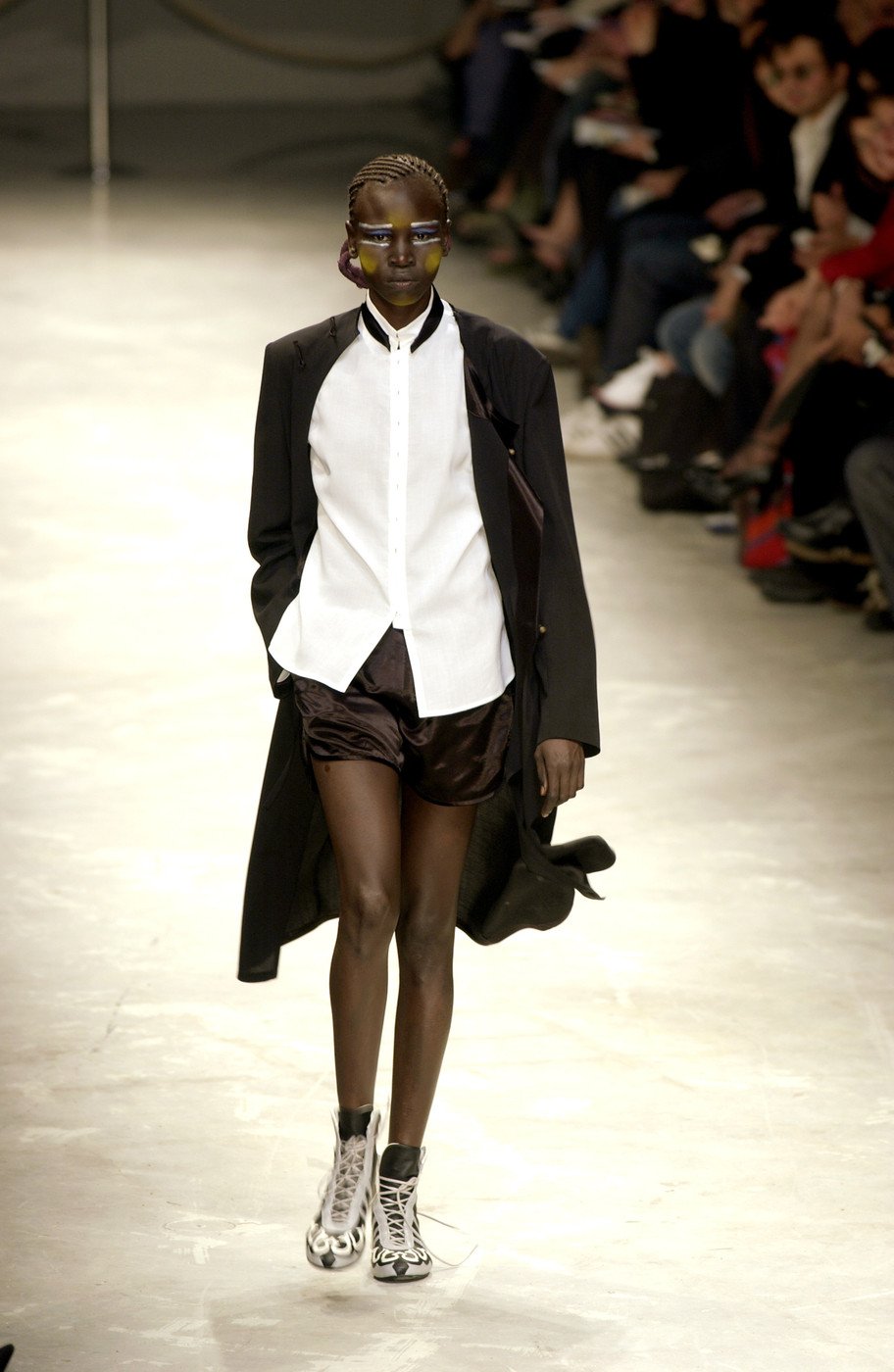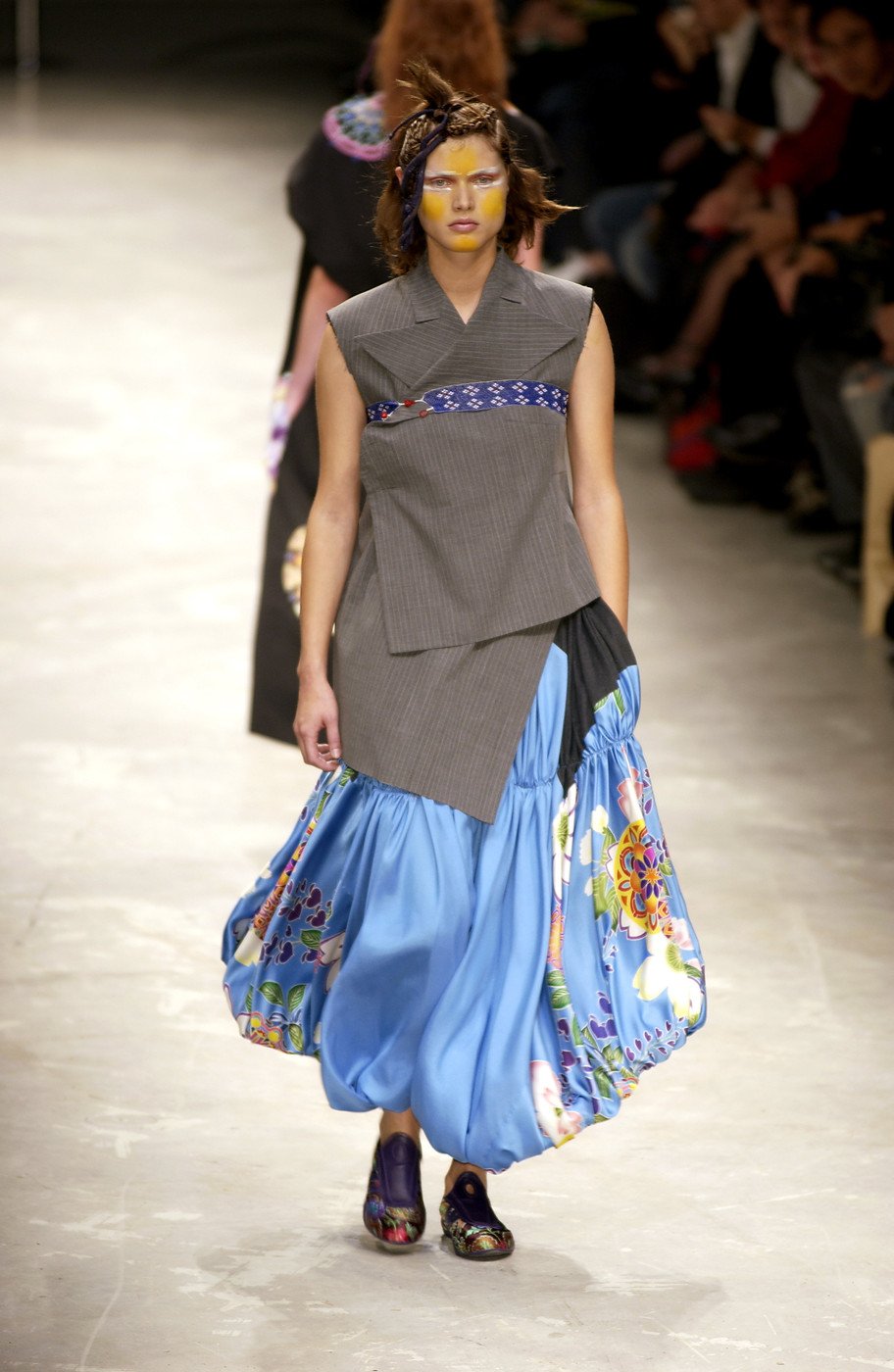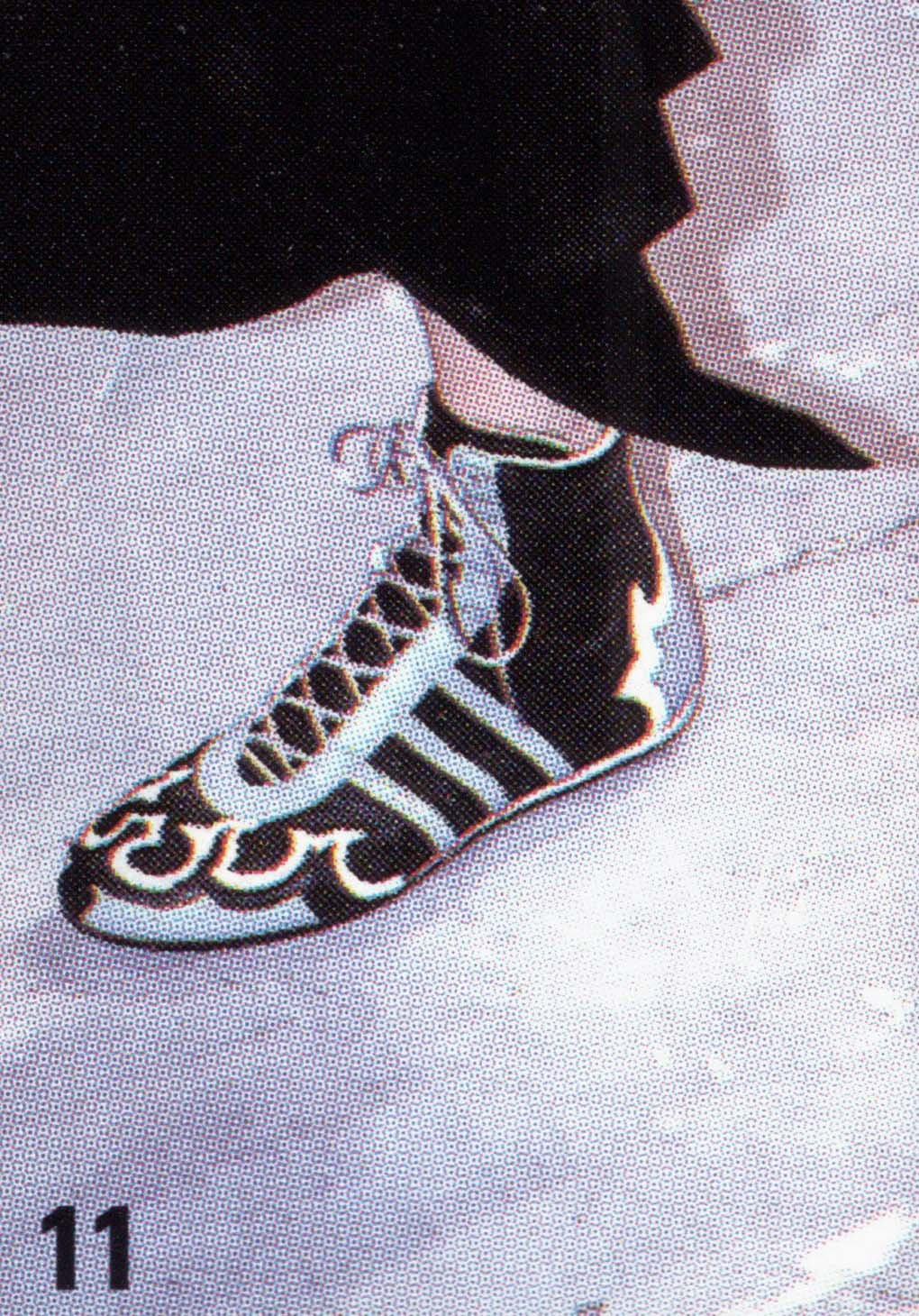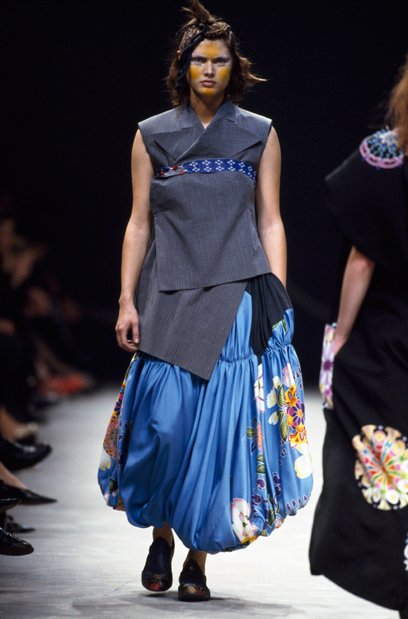Yohji Yamamoto
Spring/Summer 2002
Yohji Yamamoto Collections
2014
Yamamoto & Yohji
Published by Rizzoli
Flat cuts and Buddhist texts extend an invitation to meditation and peace; yûzen and shibori printing techniques pair up with the graphic, urban signs of sport and the almost immaterial lightness of dance. Feet dress up in trainers with a feminine touch of embroidery.
Yohji Yamamoto Spring 2002 Ready-to-Wear Collection
October 5, 2001
Vogue
Yohji Yamamoto's cult status derives from his blending of contemporary Western tailoring with elements of traditional Japanese dress—a combination that was brilliantly explored in his collaboration with Adidas for Fall 2001.
For Spring, Yamamoto returned to some of last season's sports-inspired themes. Athletic bodysuits were worn under lightweight wrap skirts held up with thin shoulder straps; cropped, shiny zip-up blousons gave flowing gowns a streetwise appeal. Yamamoto deconstructed masculine suits by hacking off their sleeves and cinching jackets with decorative bands, or removing their back panels and replacing them with long braids of shredded fabric. Less severe were the floral-printed pantaloons, draped dresses and flowing skirts with pockets concealed in the waistband.
Yamamoto's partnership with Adidas is proving to be an extremely fruitful one. Sneaker collectors will not want to miss out on the fabulous three-stripe high-tops and scalloped-edge trainers.
Taking a Back Seat To Unfolding Events
October 9, 2001
The New York Times
Written by Ginia Bellafante
[…] Nor was it easy to understand why Yohji Yamamoto's show took longer to sit through than some works of Noh theater. Mr. Yamamoto invoked kimono prints to make athletic pants. He played with satin bombers, making them look like so many variations of a Members Only jacket. There is always a place for Mr. Yamamoto's quiet poetry, but sometimes you can't help feeling that life is too short.
Refugees at the Ritz
October 9, 2001
The New York Times
Written by Guy Trebay
A quiet panic seems to hang in the air at the spring 2002 ready-to-wear collections in Paris, affecting even the most heedless observers of fashion's ongoing parade. It is not that the city itself has reacted with conspicuous alarm to the terrorist attacks in the United States and the allied bombing of Afghanistan. As beautiful as ever under chalky autumn skies, the city is steadfast in conforming to its pictorial clichés, and its residents to their temperamental ones. The overarching anxiety takes a subtler form.
Despite a shaky economy, luxury suppliers remain busy. […]
Tickets to fashion shows are still being bootlegged. Fanatics, of the fashion sort, are still sneaking into shows. In certain cases, stealth has been anything but necessary; on Saturday, a number of fans headed for the concert of the rhythm-and-blues singer R. Kelly accidentally wandered into Yohji Yamamoto's show, which was held in another part of the sports arena the two events shared. […]
RUFFLE RIOT
October 17, 2001
South Florida Sun-Sentinel
Written by Rod Stafford Hagwood
The Paris spring 2002 shows were relentlessly upbeat.
In spite of (or perhaps because of) the terrorist attacks, the runway shows in Paris, which ended Friday, were full of flouncy, frilly, floral, feminine fashion. The designers in fashion's capital were carrying on -- either bravely or insanely, depending on whom you believe.
Only Karl Lagerfeld made any mention of the attacks in America by dedicating his Chanel show to the "... memory of all victims of international terrorism. We share the world's hopes for peace to prevail."
That contrasted nicely with Yohji Yamamoto, whose cool and calm collection came emblazoned with ancient Buddhist sayings. One that was repeated often said, "Shut your eyes and there is nothing in the world." […]
2002年春夏パリ・コレクション
Paris Prêt-à-Porter Collections 2002 Spring-Summer
February 2002
High Fashion No.283
Photography by Shin Shin and Koichiro Matsui
Report by Ikuko Fujii and Misako Tamagawa
日本と中国のフォークロア、先シーズンから続くアディダスとのコラボレーションのスポーツ、そしてオートクチュールテクニックなど文化やスタイルが融合し、静けさの中の強さを示した。刺し子、シルクのきもの地に万華鏡のような優雅な手がき友禅、あるいはモノクロームの般若心経文字。日本や中国からのインスピレーション、ドレープやねじりのテクニック、スポーツを連想させるサテンのミニブルゾンや3本線のパンツ。ヨウジのクリエーションを一歩進めた集大成的モダンな作品。足もとのアディダスシューズと三つ編みヘアが若さと軽快さをプラスする。
Japanese and Chinese folklore, sportswear from the continuing collaboration with adidas that began last season, haute couture techniques, and so forth: a fusion of cultures and styles demonstrating strength in serenity. Sashiko, elegant kaleidoscope-like hand-drawn yūzen on silk kimono fabric, or monochromatic sutras from the Heart Sutra. Taking inspiration from Japan and China, draping and twisting techniques, satin mini-blousons, and 3-stripes pants associated with sportswear. A modern work that is the culmination of Yohji's creations taken one step further. The adidas shoes on the feet and braided hair add youthfulness and lightness.
1981/2002
2002
Yohji Yamamoto: Talking to Myself
Published by Steidl/Carla Sozzani
Photography by Monica Feudi
SUMMER 2002
Palais Omnisport de Paris Bercy
Flat cuts and Buddhist texts extend an invitation to meditation and peace; yûzen (technique used for printing fabric, created by Miyazaki Yûzensai at the end of the 17th century, utilizing rice paste reserves) and shibori (tie & dye) printing techniques pair up with the graphic, urban signs of sport and the almost immaterial lightness of dance. Feet dress up in trainers with a feminine touch of embroidery.
パリコレ30年の軌跡
30 Years of Paris Collection
March 2011
FASHION NEWS Special Vol.161
キモノを連想させる平面的なカッティング、絞りや友禅といったジャポニスムからの着想が久しぶりに大きくフィーチャーされたシーズン。前シーズンに続き、スニーカーや3ラインのモチーフで「アディダス」とのコラボを提案。般若心経の経文がアクセントになる。
The season featured for the first time in a long time a large number of Japonisme-inspired items, such as flat cuts reminiscent of kimono, shibori, and yūzen. Continuing from the previous season, the collaboration with "adidas" is offered in the form of sneakers and 3-stripes motifs. The sutras of the Heart Sutra serve as accents.
たかが服、されど服 ――ヨウジヤマモト論
2010
Published by 集英社
With my eyes turned to the past, I walk backwards into the future
2011
Yohji Yamamoto
Published by Victoria & Albert Museum
Photography by Monica Feudi
Archives Yohji Yamamoto Paris Women’s Collection 1981-’82 Autumn/Winter - 2014 Spring/Summer
2014
All About Yohji Yamamoto from 1968
Published by Bunka Publishing Bureau
Yohji Yamamoto: processes & techniques
2011
Victoria and Albert Museum
Processes and Techniques
Yohji Yamamoto's custom-made textiles use a variety of traditional Japanese techniques and other more common weaves such as gabardine and tweed. All his fabrics are made in Japan to his own specifications, making them unique to his designs.
'Fabric is everything. Often I tell my pattern makers, "Just listen to the material. What is it going to say? Just wait. Probably the material will tell you something."'
- Yohji Yamamoto
Fabrics
The importance of the fabric is tangible in every Yamamoto piece. From deciding the exact balance between the warp and the weft of the fabric and dyeing it the ideal hue to establishing the number of washings required to achieve the perfect balance between new and old, every fabric Yamamoto uses is specially created for him in Japan. Yamamoto's preference for exceptionally heavy fabrics and textiles not generally utilized in womenswear, high fashion or even clothing in general lends a particular slant to his sartorial language.
Embroidery
Yohji Yamamoto often uses embroidery, both hand and machine-made, particularly for his menswear designs as can be seen in Autumn/Winter 2006-7, Spring/Summer 2009 and 2011 collections. These intricate decorations contribute to Yamamoto's underlying desire to subvert people's perceptions of what men and women should wear.
Knitwear
The use of knitwear in Yohji Yamamoto's work often emphasises his wish to create space between the garment and the body. The heavy knit featured in both his Autumn/Winter 1998-99 womenswear and Autumn/Winter 2006-7 menswear collections, give the wearer the possibility of inhabiting the garment naturally, without being restricted by a predetermined form.
Shibori
Shibori is a particular method of dyeing cloth by binding small areas with either silk or cotton thread and using a wooden bucket to isolate areas to be dyed. Due to its intricate nature, it is one of the most work-intensive and expensive ways of dyeing. Yohji Yamamoto used this technique in his Autumn/Winter 1994-5 and Spring/Summer 1995 womenswear collections.
Yuzen
Kyo-yuzen is a dyeing technique which originated in Kyoto in the 1700s and is traditionally used for Kimonos. It consists of over 20 steps including design, drawing, gluing, dyeing and decorating. Yohji Yamamoto uses this dyeing method frequently, often through non-traditional motifs as can be seen in his Autumn/Winter 2009-10 menswear collection.
Loose grey pinstriped sleeveless suit jacket, date-jime belt - sash used to tie and hold in place under kimono and outer kimono and blue yuzen-dyed, patterned full skirt, Yohji Yamamoto, Spring/Summer 2002.
Screenprinting
スポーツブランドのモードスタイル
Sports Brands’ Fashion Style
May 2002
SO-EN
Photography by Hiroya Kitai, Josui Yasuda, and Monica Feudi
Hair by YAS (AUGVST)
Makeup by YOSHi (AUGVST)
Modelling by Yasuha
Coordinated, written, and edited by Kazushi Takahashi
ヨウジヤマモトはアディダスとともにシューズを作り、クリストフ・ルメールはラコステのウェアをデザイン。WRがディレクションするアーノルドパーマー、コラボレートの先駆者ルコックスポルティフなど、スポーツブランドが大きく注目されている。時代の新しいファッションは、モードとスポーツシーンがお互いに手を結んで生み出した、コラボレートスタイル。
Yohji Yamamoto makes shoes with Adidas, and Christophe Lemaire designs clothing for Lacoste. Sports brands such as Arnold Palmer, directed by WR, and Le Coq Sportif, a pioneer in collaborations, are attracting a great deal of attention. The new fashion of the times is a collaborative style created by the fashion and sports scenes joining hands with each other.
ヨウジヤマモト+アディダス:スニーカーオートクチュール
「オートクチュール」といえばパリのサンディカに属するメゾンの意味だが、直訳すると「高級な仕立て」のこと。ヨウジヤマモトがアディダスと共同で生み出したシューズはまさに「特別」。手工業に匹敵するほどに賛沢な素材・縫製を用いて丹念に仕上げられている。「スニーカー」という名称の意味が大きく変わった。ブルゾン¥72,000、パンツ¥75,000ヨウジャマモト/靴¥45,000アディダスフォーヨウジヤマモト(すべてヨウジヤマモト)
Yohji Yamamoto + adidas: Sneakers Haute Couture
"Haute couture" refers to the maisons belonging to the Syndicat of Haute Couture in Paris, but the direct translation is "high tailoring." The shoes created by Yohji Yamamoto in collaboration with adidas are truly "special". They are painstakingly finished using materials and sewing techniques that are as good as handmade craftsmanship. The meaning of the name "sneakers" has changed dramatically. Blouson ¥72,000, pants ¥75,000 Yohji Yamamoto / shoes ¥45,000 adidas for Yohji Yamamoto (all at Yohji Yamamoto)
exclusive craftwork
シルク布を腰に巻いてひもを肩に掛けて着るスカート。京都の一流職人による「手描友禅」。一枚一枚絵をかくように筆やはけで染色していく技術と美意識は伝統のクラフツマンシップに支えられている。ドイツのアディダスにも、体に優しく美しさを備えた靴を半世紀以上探究し続けた歴史がある。ヨウジヤマモトは民族と異業種の独自文化を再構築させて、今の時代に最も訴求力のあるスタイルを導き出した。トップのレオタード¥30,000、スカート¥1,300,000ヨウジャマモト/靴¥48,000アディダスフォーヨウジヤマモト(すべてヨウジヤマモト)
exclusive craftwork
A skirt made of silk cloth wrapped around the waist and worn over the shoulders with a string. "Hand-painted yūzen" is made by Kyoto's top craftsmen. The technique and sense of beauty of dyeing each piece with an ink brush or paintbrush as if drawing a picture is supported by traditional craftsmanship. adidas of Germany also has a history of more than half a century of searching for shoes that are gentle to the body and have beauty. Yohji Yamamoto has reconstructed the unique cultures of ethnic groups and different industries to derive the most appealing style for the current era. Top leotard ¥30,000, skirt ¥1,300,000 Yohji Yamamoto / shoes ¥48,000 adidas for Yohji Yamamoto (all at Yohji Yamamoto)
なぜadidasとコラボレートを続けるのか?
アディダスの担当者マイケル・ミカエフスキーは、パリ・コレクションを見終わって山本耀司に告げた。「あなたがたがこれからも本気で続けたいのであれば、私たちにはいつでもその用意があります」。最初のコラボレートスニーカーが発表されたパリにおける一幕。お互いに尊敬し合い、フレンドリーに共同作業を続けられる関係性。真のコラボレーションとはそういうものだとヨウジヤマモトは考えている。アディダスとの間に堅苦しい約束事はない。最新のメンズラインを含めて3度めのシーズンを迎えている今でも。
「スニーカー会社と、どこにもないスニーカーを作りたい」。ヨウジヤマモトがアディダスとコンタクトを取ったのはそんな発想からだった。手始めにEメールでドイツ本社に申し入れをすると、即答で「応じる意向があります」と返信が来た。しかしその後の作業は決して楽ではなかった。アディダスにとってファッションブランドとの本格的なコラボレーションは初の試み。スタッフがコンセプトを伝えるためにドイツへ渡りニュルンベルクの本社に行くと、すでにベースとなるサンプルや絵型が用意されていた。世界中に支社を一持つアディダスは各国のトレンドやスタイルを完全なまでに掌握している。ヨウジヤマモトの世界観を理解したうえで、彼らは自分流の提案をしてきたのだ。「以前にウェアでやったような花のプリントをスニーカーに施してみては」というように。ヨウジヤマモトは提案をポジティブに受け止めた。
アディダスとシューズを作ることが決定した時に、山本耀司は別の構想を練り始めていた。それは「3本線をウェアに使う」ということ。コレクションのテーマは「スポーツ」。スニーカーのベーシックモデルと同様に、スリーストライプス(3本線)はアディダスにとって聖域に等しい。半世紀前からシンボルとして商標登録されている。最終的に使用が許されたかどうかは既知のとおり。コレクションは大成功を収め、コラボレートスニーカーにも賞賛の声が上がった。
もはやアディダィスはヨウジヤマモトが次に出してくるアイディアを楽しみに待つようになっていた。相手が受け止めてくれるなら続けるべき、そんな理念も手伝って春夏に向けて2度めのスニーカー作りがスタート。お互いの信頼関係が成立した今ならもっと踏み込んだ発想ができる。オートクチュールのような高級志向も可能だ。柔らかく伸びるカンガルー革のウェスタンブーツ、豪華な刺繍を施したスリッパ、ドレッシーなジャカードがボディを彩る瞑想用シューズ。機能に妥協を許さないアディダス、スタイルに強固な意志を持つヨウジヤマモト。双方のこだわりが最良の地点で合意した結果がここにある。共同の仕事がとぎれる期間があっても、また再び手を握り合うだろう。京都の友禅染め職人との長きつきあいのように、ヨウジヤマモトに新たな友が加わったのだ。
Why continue to collaborate with adidas?
adidas representative Michael Michalsky told Yohji Yamamoto after seeing the Paris collection, "If you really want to continue, we are always ready." The first collaboration sneaker was unveiled in Paris. A relationship of mutual respect and friendly collaboration. Yohji Yamamoto believes that this is what true collaboration is all about. There is no rigid commitment with adidas. Even now, for their third season, which includes the latest menswear.
"I want to work with a sneaker company to create sneakers that don't exist anywhere else." It was with this idea in mind that Yohji Yamamoto contacted Adidas. He first sent an e-mail request to the German headquarters, and he immediately received a reply saying, "We are willing to accept the offer." However, the work that followed was nothing but easy. This was adidas' first attempt at a full-scale collaboration with a fashion brand. When the staff traveled to Germany to visit the headquarters in Nuremberg to present the concept, they found that basic samples and drawings had already been prepared. adidas, with one branch office overseeing the globe, has complete grasp of the trends and styles of each country. Understanding Yohji Yamamoto's worldview, they came up with their own proposals. "Why don't you try putting a floral print on sneakers like you've done on clothing before?" Yohji Yamamoto accepted the suggestion positively.
After the decision to make shoes with adidas was made, Yohji Yamamoto began to develop another concept. That is, "using the three stripes in clothing." The theme of the collection was "Sports." As with their basic sneaker model, the three stripes are sacred for adidas. It has been a trademarked symbol for half a century. Ultimately, they allowed Yohji Yamamoto to use the three stripes. The collection was a huge success, and the collaborative sneakers were praised.
adidas was already looking forward to Yohji Yamamoto's next idea. If the other party is receptive, it should continue, and this philosophy helped them embark on a second round of sneaker production for the Spring/Summer season. Now that a relationship of mutual trust has been established, they can take their ideas further. High-end, haute couture-like designs are also possible. Western boots made of soft, stretchy kangaroo leather, luxuriously embroidered slippers, and meditation shoes adorned with dressy jacquards. adidas never compromises on function and Yohji Yamamoto has a strong determination for style. Here is the result of both sides arriving at the best possible point of agreement. Even if there is to be a break in their joint work, they will hold each other's hands again. Like the long relationship with the yūzen dyeing craftsmen in Kyoto, Yohji Yamamoto has made a new friend.
2002SSオールモデル
春夏のモデルをすべてリストアップ。デザインは9型で、色バリエーションを含めて計31体。ヨウジヤマモトのショップだけでなくアディダスショップで取り扱われているモデルもある。Hills Leatherにはアッパーがインディゴ、ソールがオレンジのものがあり、アディダスショップでのみ購入することができる。
All 2002SS Models
All Spring/Summer models are listed. There are 9 designs and a total of 31 models including color variations. Some models are sold not only at Yohji Yamamoto shops but also at adidas shops. The Hills Leather with an indigo upper and orange sole is available exclusively at adidas stores.
2002, YY Mei Brocade
August 18, 2019
Twitter
@adidas
The 2000’s were a decade for collaborations, making adidas the first in the industry to introduce a new lifestyle segment, focusing on sports-inspired streetwear. Yohji Yamamoto released the YY MEI Brocade, paving the way for Y-3.
Yohji Yamamoto, Spring/Summer 2002 Catalog
2002
Photography by Peter Lindbergh
Design by Giovanni C. Russo / No 11
Modelling by Justine Bakker, Katerena, and Olga
Styling by Aleksandra Woroniecka
Hair by Odile Gilbert
Makeup by Emmanuel Sammartino
Kirsten Dunst
June 2002
Esquire
Photography by Marc Baptiste
To The Sea
February 2002
High Fashion No.283
Photography by Risaku Suzuki
Makeup & hair by Kimiyuki Misawa
Modelling by Lulla
Flowers
February 2002
High Fashion No.283
Photography by Mika Ninagawa
Makeup & hair by Naoyuki Akama
Modelling by Sachi, Fason, and Mio
The Day Yohji Yamamoto Went Surfing
February 9, 2018
Outerknown
Written by Jamie Brisick
Photography by Taisuke Yokoyama
"I was under a preconception that surfers were like punk wannabes preoccupied with being cool or bad and the whole point of it was like doing tricks."
- Yohji Yamamoto
About fifteen years ago, Takuji Masuda met fashion designer Yohji Yamamoto while working on a project in Japan. Tak is one of surfing’s great ambassadors, turning people onto the sport of kings is one of his biggest joys. Yohji is a masterful and avant-garde tailor, the founder the labels Yohji Yamamoto and Y3. Tak brought Yohji to a spot near Kamakura, a beginner-friendly wave just outside of Tokyo. He pushed him into the knee-high rollers. “It was like undressing the dresser,” laughs Tak.
Later, Tak asked Yohji for his take on the session. Here’s what he said: “I really think you have to stick to your attitude towards what you are doing. I say this because for non-surfers there is a sort of high fence to enter that culture.
Very uninviting image. Oh, I had this image of surfing before I went. But after going to the beach with you and your friends the other day, my image for surfing completely changed. I was under a preconception that surfers were like punk wannabes preoccupied with being cool or bad and the whole point of it was like doing tricks. However, you were like, ‘No, it’s not like that.’ The most impressive thing for me that day was to find that you people were intensely focused on playing with the sea, having a blast. It was like seeing men being childish in a very good way. And if it’s like that, I can really get into it.”
Photographer Taisuke Yokoyama was on hand to shoot pics. Below are a few.



































